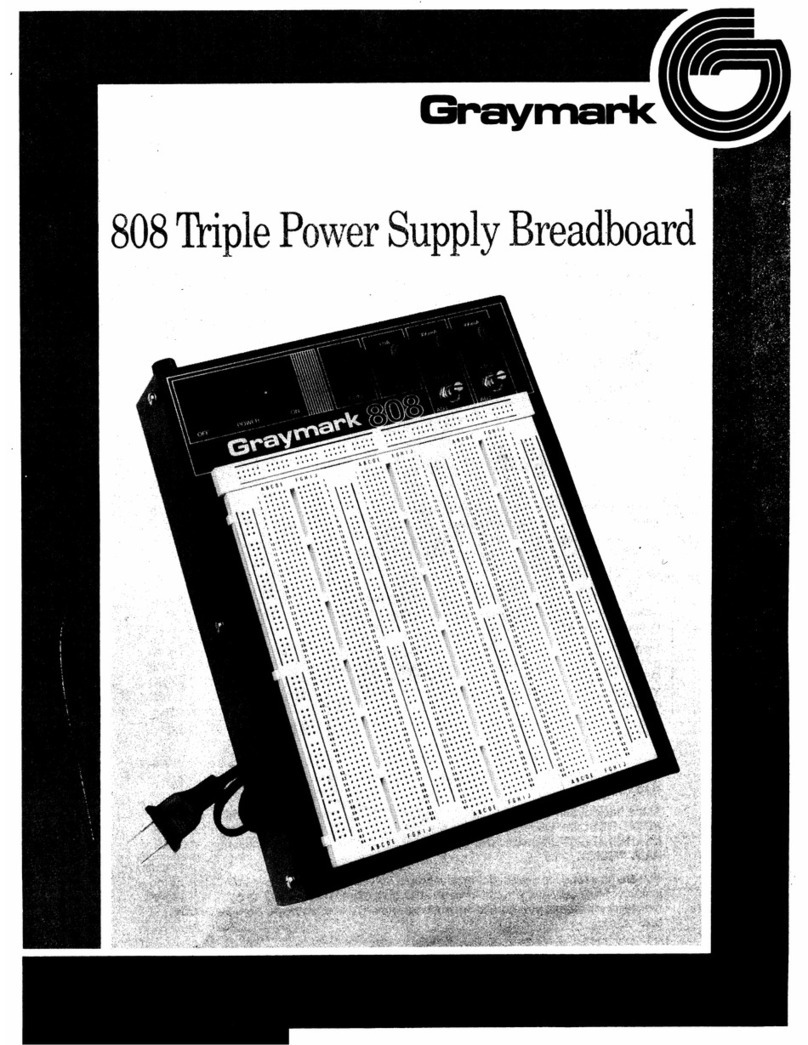Graymark 803 User manual

POWERSUPPLY
0esigned and pmted in U.S.A.
Dr
I
Subsidiary of Buck Engineering Co., lnc.
tNTEFINATIclNAL,INC. 7I
L:'',
@
@

INTRODUCTION
Your model 803 is specially designed for applications requiring a low voltage DC
power source. lt provides a continuously variable output of 0-15 Vdc at up to
300mA of current at full load. lt is ideal for use as a battery eliminator for
tr"ansistor radios, amplifiers, oscillators, etc. or you may use it as a convenient
voltage source for designing, experimenting, repairing and testing low voltage
semiconductor devices and circu its.
Your Power Supply is constructed in three PHASES, which will allow you to
experience many fascinating and meaningful experiments and will give you a
solid foundation in voltage rectif ication and power supply design.
PHASE I consists of constructing the unit in a breadboard form. Breadboarding is
a common technique used by electronic engineers and technicians in industry.
By using this technique, you achieve an over-all assembly of the circuit, which
demonstrates the inter-relationship of components as well as gives you easy
access for circuit testing. Thus, the construction and testing of PHASE I enables
you to understand the HOW and WHY of the unit's circuitry. If you are
constructing this proiect without the supervision of an instructor, you may omit
PHASE I and go directly to PHASE ll.
PHASE ll is, industrially speaking, the assembly operation. This phase is con-
cerned with arranging the components and fittings onto the chassis. This phase
will provide you with experiences such as, component identif ication, component
mounting, solder techniques, lead dress, and final assembly into the plastic
cabinet.
PHASE lll provides you with Operation tnstructions, Product Specif ications,
Learning Experience and Skill Development Review, and Review Evaluation. At
the back of this book is a section on servicing and parts replacement, which gives
a Service Flow Chart for your use in troubleshooting problems and gives
information on ordering replacement parts and on f actory servicing.
You are now ready to start constructing your power supply. Follow the in-
structions closely and you will have a worthwhile project, one that you can be
proud of and one that you will enjoy assembling.
TOOL REOUIREMENT
lllustrated below are the tools necessary to assemble your project. Additional
tools, such as nut drivers, pliers, and soldering aids, make circuit assembly easier, but are not required.
WIRE STRIPPER
SCREWDRIVERS, PHILLIPS HEAD
1-LARGE
SCREWDRIVERS, 1 - Ta" BLADE
1 -V8" BLADE
DIAGONAL CUTTERS
GRAYMARK INTERNATIONAL, INC.
SUBSIDIARY OF BUCK ENGINEERINC CO. INC.
2
P/N 61S4U rc
All righa reserued. This book ot patts thereol may not be reproduced in
any torm without violating the copyright law. Printed in U.S.A.
LONG NOSE PLIERS

PROGRESS GUIDE
-: rurpose of this Progress Cuide is to allow you to keep
.- rccurate record of your progress in construicting and
- - -:rstanding the electronic fundamenta!s contained in this
:- ict. To develop this basic understanding, be sure to
.,,=--lble this project in the sequence outlined below. Do
- : rroceed to the next experience until the previous one is
fully understood.
If the porver supply is being built for a school project, you
should obtain your instructor's initials at the completion of
each learning experience. The Final Evaluation is provided
so that your instructor can indicate your degree of achieve-
ment on the entire project.
rur Narne:
PARTS IDENTIFICATION
AND INVENTORY EXPERIENCE
SOLDERING EXPERIENCE
TRANSFORMER EXPERI ENCE
Construction
Instrumentation And Measurement
FULL-WAVE RECTIFIER EXPERIENCE
Construction
lnstrumentation And Measurement
FILTER CIRCUIT EXPERIENCE
Construction
lnstrumentation And Measurement
VOLTAGE CONTROL EXPERIENCE
Construction
Instrumentation And Measurement
PHASE II
CHASSIS ASSEMBLY
CHASSIS CONSTRUCTION
CIRCUIT TEST
CABINET ASSEMBLY
PHASE III
EVALUATION
REVIEW EVALUATION
FINAL EVALUATION
EVALUATION INSTRUCTOR'S
INITIALS
PHASE I
BREADBOARD

PARTS LIST wooel 803 Power Supply
ktl PART
NO. REPLAGEMENT
PRICE
$1.s0
.25
1.00
1.00
2.00
*Attached to Panel
PARTS IDENTIFICATION
DESCRIPTION
Potentiometer, 10K ohms, w/lockwasher
Resistor, fixed, 820 ohms, VzW, 10o/o
Besistor, fixed, 1K ohms, %W, 10%
Capacitor, electrolytic, 100 pF, 35WV
Capacitor, ceramic disc, .02 iiF, 50V, (marked223)z
Capacitor, electrolytic, 470 pF, 16WV
Diode, silicon, power,50 PlV, 1A
Diode, zener, 16V
nsistor, power, with 2-insulatingwashers-
Transtormer, power, P :117Y, S : 40V, at 135 mA"
Terminal Strip, 4P-l
Line Cord, AC, 2-conductor, with molded plug
Knob, plastic
Line cord stopper, plastic
Terminal post, with mounting hardware, red
Terminal post, with mounting hardware, black
Plastic tubing, Black,5" length
Plastic tubing, clear, '1 "
wire, 1-red, 1-blue and 1-yellow
Solder, rosin core, 60l40
Self-tapping screw
Washer, shoulder, insulating
Washer, f lat, insulating
Panel, steel
Cabinet, plastic
lnstruction Manual
RESISTOR
r-\ \r
S-----)
\ DISo cAPAClroR
KNOB SELF-TAPPING SCREW
005*€BM,NAL
POST TERMINAL STRIP
,>. 6, @
\d.,*E coRD V/FLAr V.fi,?Bh?.*-
TRANSFORM ER
r-L
l'
ELECTROLYTIC
CAPACITOR
ZENER DIODE STOPPER WASHER
5.00
1.00
.50 set
.10 ea.
.-l-
r-L\
VY
/- \
NPN TRANSISTOR
--x--
I PoTENTToMETER

POWER
(AC)
SCHEMATTC DIAGRAM c2.
1st COLOR 2nd COLOR 3rd COLOR
BAND COLOR FIRST FIGURE SECOND FIGURE MULTIPLIER
OUTPUT
(DC)
RESISTOR COLOR CODE
. First color (color nearest the end of the resistor) represents the first figure in the resistor value
o Second color represents the second figure in the resistor value.
o Third color represents the multiplier of the first two figures.
. Fourth color represents the resistor tolerance. 4ih coloR
TOLERANCE
BLOCK DIAGRAM
NO COLOR
SILVER 10%
GOLD
BLACK
BROWN
RED 100
1,000
ORANGE
YELLOW 10,000
GREEN 100,000
BLUE 1,000,000
VIOLET 10,000,000
GRAY 100,000,000
WHITE 1,000,000,000
Red Violet Orange
27000
Creen Blue Red
5600
Silver
1O"/o :27000 or 27K ohm,10%
Silver
10o/o : 5600 or 5.6K ohm,'10%
EXAMPLE:
20"/"
T1
117Y
"Hl
LJ
5
Table of contents
Other Graymark Power Supply manuals
Popular Power Supply manuals by other brands

Videx
Videx 520MR Installation instruction

Poppstar
Poppstar 1008821 Instructions for use

TDK-Lambda
TDK-Lambda LZS-A1000-3 Installation, operation and maintenance manual

TDK-Lambda
TDK-Lambda 500A instruction manual

Calira
Calira EVS 17/07-DS/IU operating instructions

Monacor
Monacor PS-12CCD instruction manual












